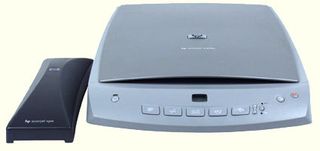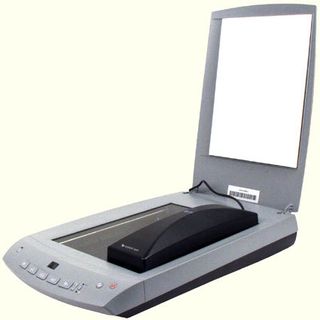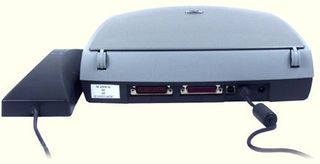Under Scrutiny: Four 1200 dpi Scanners
HP Scanjet 4470c

HP once decided to produce efficient but rather crude scanners. Design was obviously a secondary consideration for this manufacturer, who didn't even attempt to hide the fact! But strategies have since changed. The 4470c is a good example: it has a very attractive aerodynamic design, is dotted with buttons, attractive colors, a backrest for slides, and even a miniature LCD screen that is frankly not indispensable, but nevertheless welcome.

While the aesthetics of this scanner are commendable, this is far from the case with the driver, whose interface seems to have been inherited from Windows 3.1. Using the excuse of an attempt to simplify its use to the maximum, HP has limited the default parameters available to the bare minimum. So much so that, if you are not happy with the interface as it is without venturing into the menus, you will not even be able to choose the resolution! If the scanned image is in color, the resolution will be only 150 dpi.

Therefore, your initial reaction when launching the driver for the first time is to resort to the Tools menu and activate the "change resolution" option. This action will result in the appearance of a free-floating scroll menu that is indispensable because it lists the available resolutions, from 75 through 2400 dpi. Once you have made your choice and finished scanning, the driver closes automatically. This is useful if you only have one scan to perform, but frustrating if you intend to do a series of scans. But worse is yet to come: if you want to capture a series of photos from magazines, this is what you will have to do for each photo:
- Open the driver.
- Automatic pre-scanning begins, 13 seconds, which cannot be stopped. The carriage returns to the starting point, which takes 8 seconds.
- Go to the Advanced menu and select "Descreen."
- Automatic pre-scanning begins again, which takes another 13 seconds, and again, it's impossible to stop. Carriage returns to its start position, 8 seconds.
- Then, finally, you can start scanning, which takes 24 seconds, and your image can then be saved, but you must go right back to step one for the next photo.
As you can see, it's a pretty slow process (more than one minute per photo!) and not exactly optimized.

Fortunately, the scanner does much better on other points, starting with its very good work at low resolution. When used at 75 dpi, the 4470c is quick and reliable. The colors are bright and sharper than those of its rivals. The main defect, when all's said and done, is the same as that of Epson's Perfection 1250: an inefficient scanning procedure and slowness at resolutions above 600 dpi. As for the scanning itself, the processed image can be improved by softening it slightly in Photoshop. But this involves more manual settings, of course.

Stay on the Cutting Edge
Join the experts who read Tom's Hardware for the inside track on enthusiast PC tech news — and have for over 25 years. We'll send breaking news and in-depth reviews of CPUs, GPUs, AI, maker hardware and more straight to your inbox.
Most Popular

